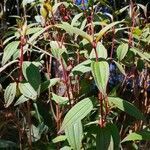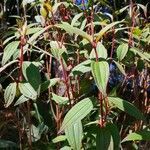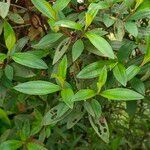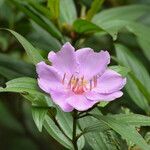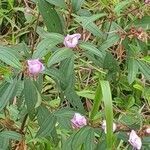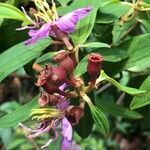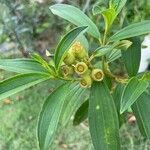Shrubs 0.5-1(-5) m tall, erect. Stems 4-sided to subterete; branchlets numerous, procumbent, densely covered with appressed scales. Petiole 0.5-1.9 cm; leaf blade ovate, elliptic, or elliptic-lanceolate, 4-14 × 1.7-3.5(-6) cm, stiffly papery, abaxially densely strigose and puberulous, adaxially densely strigose, secondary veins 2(or 3) on each side of midvein, tertiary veins numerous and parallel, base rounded to subcordate, margin entire, apex acuminate. Inflorescences subcapitate corymbose, terminal, 3-7-flowered, with 2 leaflike bracts at base. Pedicel 2-8(-10) mm, strigose, apically 2-bracteolate, bracteoles lanceolate to subulate, 2-5 mm, abaxially densely strigose, margin ciliate. Hypanthium 5-9 mm, densely compressed strigose, margin fimbriate. Calyx lobes lanceolate to ovate-lanceolate, apex acuminate, on both sides and along their margin squamosly strigose and pubescent. Petals reddish purple, 2-3(-4) cm, margin only ciliate, apex rounded. Longer stamens with connective long extended at base, curved, apex bifid. Shorter stamens with anthers 2-tuberculate at base; connective not extended. Ovary half inferior, densely strigose, apically with a ring of setae. Fruit urceolate-globular, 6-15 × 6-12 mm, succulent, densely squamose strigose. Fl. Feb-Aug, fr. Jul-Dec.
More
An evergreen shrub. It grows about 2 m high. The branches are nearly four angled. They are densely covered with scales. The leaves have stalks. The leaves are 3.5-10 cm long by 1.4-3 cm wide. They are broadly sword shaped. They have hairs on the upper surface and a few underneath. The flowers are purple. The fruit is oval with a blunt end. The pulp of the fruit is red.
A tropical plant. It suits the hot, wet tropical lowlands. In Nepal it grows between 200-1600 m altitude. In Yunnan in China it grows below 1800 m altitude. It grows in secondary forest. It needs regular moisture and humidity. It grows in wetlands. It needs fertile, well-drained soil. It needs an acid pH. It suits hardiness zones 10-12.
More
Found in disturbed locations, on fallow land, or in grasslands from sea-level up to 3,000 metres.
